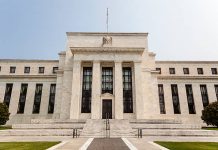- Personal income contracted by 2% m/m in March, and was weaker than market expectations (-1.5%). This was mainly due to a 2.8% decline in compensation as measures to contain COVID-19 resulted in millions of job losses. In real terms, income fell by 1.7% for the month.
- Spending fell considerably more than income, dropping by 7.5% for the month and below expectations (-5%). Excluding price effects, personal consumption contracted by 7.3% in March. With spending falling more than income, the personal saving rate increased to 13.1% from 8% in February, the highest savings rate since the 1980s.
- Spending on goods contracted by 2.2% in March, owing to a 14.8% collapse in durable goods purchases. Spending on non-durable goods, on the other hand, rose by 4.3% as consumers spent heavily on food and beverages purchased for off-premises consumption.
- Services consumption, which makes up over two-thirds of overall spending, fell by 9.5%. The main driver of the decline was spending on health care, which includes physician, and dental services. Spending also declined in food, accommodation, and recreation services.
- The PCE price deflator fell by 0.3% m/m in March owing to the decline in oil prices. Prices for energy goods and services dropped by 6.1% on the month. Excluding energy and food prices, core PCE declined by 0.1% for the month in response to the drop in demand across almost all areas of the economy.
Key Implications
- The decline in consumption and income in today’s release was not a surprise, but it is still shocking to see the magnitude of the early impacts of COVID-19 since states only started to enact social-distancing protocols in mid-March. The incoming April decline will be far worse as large parts of the economy were shuttered for the entire month.
- COVID-19 is having a disastrous impact on the backbone of the American economy. Any hope for recovery will depend on households being in a position to rebound quickly. The expanded benefits in the Coronavirus Aid, Relief, and Economic Security (CARES) Act and the Payroll Protection Program will help, but it is clear that significant segments of the population are hurting.
- As states consider plans to open up economies, it could alleviate some of the pressure on income and spending. However, the economic recovery will be gradual as social distancing measures, in some form, will likely still be in place for many months to come.












